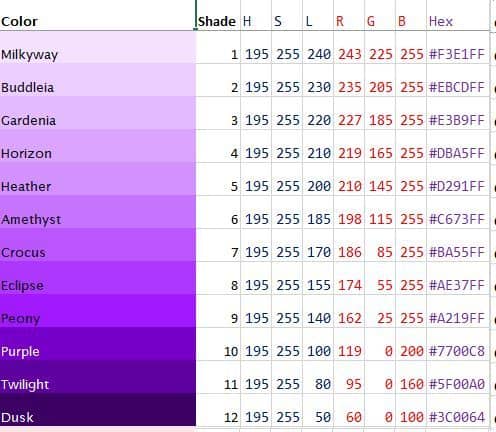Purple is a popular color that has been used throughout history for art, fashion, and decor. The specific shade of purple is determined by the mixture of red, blue, and sometimes green light. On a computer screen, purple can be created by mixing different amounts of the red, green, and blue light. This is done using RGB color codes.
RGB Color Model
The RGB color model uses varying intensities of red, green, and blue light to create the wide array of colors on a screen. RGB stands for red, green, and blue. In the RGB model, these three colors are combined in different ratios to produce all the other colors.
This additive color model works by mixing light together. The more intensity of a color, the brighter it becomes. To make purple, you combine different amounts of red and blue. The green value is typically low or zero for purple shades.
RGB Values
In the RGB model, each color has a value range of 0 to 255. This refers to the intensity of that color. A value of 0 means none of that color is present. A value of 255 is the maximum intensity.
RGB values are often written as (red, green, blue). For example, the RGB values for the color purple are:
(128, 0, 128)
This means:
– Red value is 128 out of 255
– Green value is 0 out of 255
– Blue value is 128 out of 255
By mixing medium amounts of red and blue, with no green, this makes the color purple.
Hex Codes
RGB values can also be expressed in hexadecimal format (base 16) as hex codes. This is a six-digit code prefixed with #. Two digits are used for each color value.
Here are the hex codes for some shades of purple:
| Color Name | Hex Code |
| Purple | #800080 |
| Dark Orchid | #9932CC |
| Medium Orchid | #BA55D3 |
| Medium Purple | #9370DB |
| Orchid | #DA70D6 |
As you can see, while the values vary, all the purple shades have combinations of red and blue. There is little or no green.
Creating Purple on a Computer Screen
To create a purple background or text on a website or computer application, you simply use the RGB or hex code in your CSS or design program.
For example, to set a purple background in CSS:
“`css
.purple {
background-color: #800080;
}
“`
Using the hex code #800080 will display the color purple.
In design programs like Photoshop or Illustrator, you can input the RGB or hex code into the color picker to select that exact purple shade.
Purple in Print
RGB and hex codes only work for colors displayed on screens. For print design and publications, the CMYK color model is used instead.
CMYK stands for the four ink colors:
– Cyan
– Magenta
– Yellow
– Key (Black)
These inks are combined in different rations to create all the colors in print.
To print the color purple, you would use mixtures of magenta and cyan ink. The percentages vary based on the specific purple tone.
Here are some example CMYK values for purple shades:
| Color Name | CMYK Values |
| Purple | Cyan: 50% Magenta: 100% Yellow: 0% Black: 0% |
| Dark Orchid | Cyan: 80% Magenta: 90% Yellow: 0% Black: 0% |
| Medium Orchid | Cyan: 60% Magenta: 100% Yellow: 0% Black: 15% |
These percentages of cyan and magenta ink create the purple tones.
Web-Safe Purple Colors
When designing for the web, there are 216 web-safe colors that are supported across all browsers. These include specific RGB value combinations.
Here are some commonly used web-safe purples:
| Color Name | Hex Code |
| Purple | #800080 |
| Medium Purple | #9370DB |
| Dark Orchid | #9932CC |
| Dark Violet | #9400D3 |
| Medium Orchid | #BA55D3 |
| Orchid | #DA70D6 |
| Violet | #EE82EE |
| Plum | #DDA0DD |
| Thistle | #D8BFD8 |
Sticking to these web-safe colors ensures proper display on monitors. But you can use any RGB values for digital design.
Psychology of the Color Purple
Purple is a royal color associated with luxury, wealth, and sophistication. It’s also mystical and spiritual.
Here are some psychological effects and associations with the color purple:
– Wisdom and dignity
– Luxury, royalty, and wealth
– Magic, mystery, and spirituality
– Imagination and creativity
– Independence and individuality
Darker purples like aubergine are seen as more traditional and elegant. Lighter purples like lavender represent femininity and romanticism.
This wide spectrum of shades and meanings makes purple a versatile color for branding and marketing.
Popular Purple Brands and Logos
Many major companies and brands have made purple a key part of their visual identity:
| Brand | Industry |
| Yahoo! | Technology |
| Twitch | Live Streaming |
| Hallmark | Greeting Cards |
| Milka | Chocolate |
| Cadbury | Chocolate |
| NYU | University |
| Welch’s | Food & Beverage |
| Purplebricks | Real Estate |
For these brands, purple conveys creativity, luxury, or imagination. The color helps them stand out in the minds of consumers.
Conclusion
The color purple is created by combining red and blue light on screens using RGB color codes. Specific ratios and values of red and blue make the many shades of purple.
In print, purple is achieved by mixing percentages of magenta and cyan ink. On the web, there are a number of web-safe RGB purple colors that ensure consistent display.
Purple has a wide range of meanings and impressions, from spirituality to luxury. This versatility makes it a popular choice for branding and marketing campaigns. Understanding the technical details of displaying this color allows designers to accurately work with this attractive tone.


